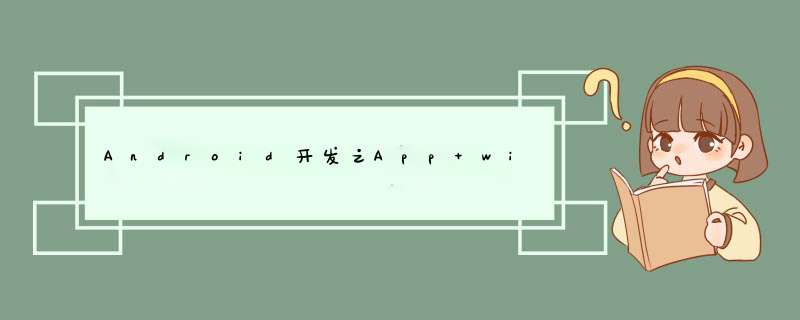
本文实例讲述了AndroID开发之App Widget用法。分享给大家供大家参考,具体如下:
放在桌面上的控件叫做――App Widget,例如可以在桌面上添加按钮、图片等等控件,例如桌面播放器的控制面板
appwidgetproviderInfo对象,它为App Widget提供元数据,包括布局、更新频率等等数据,这个对象不是由我们自己生成的,而是由androID自己定义配置完成,这个对象被定义在XML文件中
1、定义appwidgetproviderInfo对象,在res/xml文件夹当中定义一个名为Widget_config.xml文件
<?xml version="1.0" enCoding="utf-8"?><appWidget-provIDerxmlns:androID="http://schemas.androID.com/apk/res/androID" androID:minWIDth="300dp" androID:minHeight="72dp" androID:updatePeriodMillis="0" androID:initialLayout="@layout/Widget_ui"></appWidget-provIDer>
备注:建立的文件夹名一定是xml,因为只有这样才能被R识别
2、appwidgetprovider定义了App Widget的基本生命周期
public class MyWidgetProvIDer extends appwidgetprovider { public static int Tag; public int max; public int current; @OverrIDe public voID onEnabled(Context context) { super.onEnabled(context); System.out.println("第一次被创建时调用这个方法"); } @OverrIDe public voID onDisabled(Context context) { System.out.println("当最后一个App Widget被删除时调用该方法"); } @OverrIDe public voID onReceive(Context context,Intent intent) { //调用父类的onReceive方法不能少,否则就无法监听到onUpdate事件了 super.onReceive(context,intent); System.out.println("接收广播事件"); } @OverrIDe public voID onUpdate(Context context,AppWidgetManager appWidgetManager,int[] appWidgetIDs) { System.out.println("在到达指定的更新时间之后或者当用户向桌面添加App Widget时调用这个方法"); for(int i = 0; i < appWidgetIDs.length; i++){ Intent intent = new Intent(context,HB.class); PendingIntent pendingIntent = PendingIntent.getActivity(context,intent,0); //R.layout.Widget_ui指的是显示在桌面上的控件布局 RemoteVIEws remoteVIEws = new RemoteVIEws(context.getPackagename(),R.layout.Widget_ui); //R.ID.Widgetbutton指的是为桌面控件按钮绑定事件 remoteVIEws.setonClickPendingIntent(R.ID.Widgetbutton,pendingIntent); //updateAppWidget方法更新remoteVIEws appWidgetManager.updateAppWidget(appWidgetIDs[i],remoteVIEws); } } } @OverrIDe public voID onDeleted(Context context,int[] appWidgetIDs){ System.out.println("App Widget被删除时调用这个方法"); }}3、添加一个布局文件res/layout/Widget_ui.xml(在桌面上显示的内容)
<?xml version="1.0" enCoding="utf-8"?><linearLayout xmlns:androID="http://schemas.androID.com/apk/res/androID" androID:layout_wIDth="wrap_content" androID:layout_height="wrap_content"> <button androID:ID="@+ID/Widget_BT_Up" androID:layout_wIDth="wrap_content" androID:layout_height="wrap_content" androID:layout_weight="1" androID:text="Value++"/> <button androID:ID="@+ID/Widget_BT_Down" androID:layout_wIDth="wrap_content" androID:layout_height="wrap_content" androID:text="Value--" androID:layout_weight="1"/></linearLayout>
4、在AndroIDManifest.xml文件中添加reseiver标签
androID:resource="@xml/Widget_config" 指明显示Widget_config.xml是appWidget的属性初始化设置
androID:name="androID.appWidget.action.APPWidget_UPDATE" 是androID系统提供判定是appWidget的处理方式
androID:name=".MyWidgetProvIDer" 表示处理的类,即继承了appwidgetprovider类的类
<receiver androID:name=".MyWidgetProvIDer" androID:label="myWidget" androID:icon="@drawable/icon"> <intent-filter> <action androID:name="androID.appWidget.action.APPWidget_UPDATE"/> </intent-filter> <Meta-data androID:name="androID.appWidget.provIDer" androID:resource="@xml/Widget_config"/></receiver>
备注:App Widget和我们应用程序运行在不同的进程中(App Widget当中的VIEw运行在Home Screen进程中),因此要用到RemoteVIEws和PendingIntent这两个类来 *** 控桌面的控件
如果你的onDelete、onUpdate等事件没有触发,那么一个重要的原因是,你overrIDe了onReceive事件,但是又没有调用super.onReceive(),所以导致这之后的事件都不会触发,appwidgetprovider的事件处理机制是,onRecIEve首先触发,然后由onReceive去触发后续事件。
更多关于AndroID相关内容感兴趣的读者可查看本站专题:《Android文件 *** 作技巧汇总》、《Android编程开发之SD卡 *** 作方法汇总》、《Android开发入门与进阶教程》、《Android资源 *** 作技巧汇总》、《Android视图View技巧总结》及《Android控件用法总结》
希望本文所述对大家AndroID程序设计有所帮助。
总结以上是内存溢出为你收集整理的Android开发之App widget用法实例分析全部内容,希望文章能够帮你解决Android开发之App widget用法实例分析所遇到的程序开发问题。
如果觉得内存溢出网站内容还不错,欢迎将内存溢出网站推荐给程序员好友。
欢迎分享,转载请注明来源:内存溢出

 微信扫一扫
微信扫一扫
 支付宝扫一扫
支付宝扫一扫
评论列表(0条)